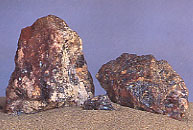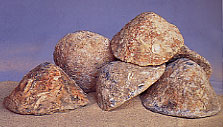| Discovering Asia's
ceramic development |
Make-up
 These
chunks of sphalerite were found in a number of storage jars on the Turiang
shipwreck, and were probably sold as glitter make-up. It flakes easily, and
could be placed on the cheekbones and in the hair. This is believed to have
been a common cosmetic during the 14-16th centuries, but the zinc sulfide it
contains would be unlikely to pass safety tests today.
These
chunks of sphalerite were found in a number of storage jars on the Turiang
shipwreck, and were probably sold as glitter make-up. It flakes easily, and
could be placed on the cheekbones and in the hair. This is believed to have
been a common cosmetic during the 14-16th centuries, but the zinc sulfide it
contains would be unlikely to pass safety tests today.
Glass beads / bangles

 Cobalt-blue
glass beads were found in a storage jar on the Xuande site. Bronze coiled
bangles in children's sizes were also found - similar to bangles known in Thailand
since prehistoric times. Although both beads and bangles were used for beauty,
they were also a form of trading currency.
Cobalt-blue
glass beads were found in a storage jar on the Xuande site. Bronze coiled
bangles in children's sizes were also found - similar to bangles known in Thailand
since prehistoric times. Although both beads and bangles were used for beauty,
they were also a form of trading currency.
Lead 'bidor'
 Tin
'bidor' were common currency in Malaysia during the 14th to 18th centuries.
Various sizes represented different values, according to the current value of
the tin content. These 'coins' are identical in size and shape to Malaysian
tin 'bidor' but are made of lead. Each weighs 1.5kg. They were found on four
ships - the Nanyang, Longquan, Royal Nanhai and Xuande
- dated tentatively to between 1380 and 1540. None were found on the earlier
Turiang or the later Singtai or Desaru. Lead 'bidor' may
have represented a different denomination of currency. Shopping seems easier
today!
Tin
'bidor' were common currency in Malaysia during the 14th to 18th centuries.
Various sizes represented different values, according to the current value of
the tin content. These 'coins' are identical in size and shape to Malaysian
tin 'bidor' but are made of lead. Each weighs 1.5kg. They were found on four
ships - the Nanyang, Longquan, Royal Nanhai and Xuande
- dated tentatively to between 1380 and 1540. None were found on the earlier
Turiang or the later Singtai or Desaru. Lead 'bidor' may
have represented a different denomination of currency. Shopping seems easier
today!
 These
chunks of sphalerite were found in a number of storage jars on the Turiang
shipwreck, and were probably sold as glitter make-up. It flakes easily, and
could be placed on the cheekbones and in the hair. This is believed to have
been a common cosmetic during the 14-16th centuries, but the zinc sulfide it
contains would be unlikely to pass safety tests today.
These
chunks of sphalerite were found in a number of storage jars on the Turiang
shipwreck, and were probably sold as glitter make-up. It flakes easily, and
could be placed on the cheekbones and in the hair. This is believed to have
been a common cosmetic during the 14-16th centuries, but the zinc sulfide it
contains would be unlikely to pass safety tests today.

 Tin
'bidor' were common currency in Malaysia during the 14th to 18th centuries.
Various sizes represented different values, according to the current value of
the tin content. These 'coins' are identical in size and shape to Malaysian
tin 'bidor' but are made of lead. Each weighs 1.5kg. They were found on four
ships - the Nanyang, Longquan, Royal Nanhai and Xuande
- dated tentatively to between 1380 and 1540. None were found on the earlier
Turiang or the later Singtai or Desaru. Lead 'bidor' may
have represented a different denomination of currency. Shopping seems easier
today!
Tin
'bidor' were common currency in Malaysia during the 14th to 18th centuries.
Various sizes represented different values, according to the current value of
the tin content. These 'coins' are identical in size and shape to Malaysian
tin 'bidor' but are made of lead. Each weighs 1.5kg. They were found on four
ships - the Nanyang, Longquan, Royal Nanhai and Xuande
- dated tentatively to between 1380 and 1540. None were found on the earlier
Turiang or the later Singtai or Desaru. Lead 'bidor' may
have represented a different denomination of currency. Shopping seems easier
today!